|
|
Effects of Structure and Properties of Polar Polymeric Binders on Lithium-ion Batteries
GUO Rong-Nan, HAN Wei-Qiang
2019 Vol. 34 (10): 1021–1029
 Abstract
Abstract(
1402 )
 HTML
HTML(
60)
 PDF
PDF(1517KB)(
2021
)
Binders have a great impact on the performance of lithium-ion batteries, although small doses of binder is applied. The traditional binder poly (vinylidene fluoride) cannot meet the requirements of modern lithium-ion batteries, especially those with high specific capacity, because it interacts with electrode materials through weak Van de Waals force. The surfaces of most electrode materials have polar groups which can strongly interact with polar polymeric binders. Therefore, the polar polymeric binders have been paid much attention, recently. Many factors of polar polymeric binders influence the properties of lithium-ion batteries. This review mainly focuses on the impacts of structure properties of polar polymeric binders on lithium-ion batteries, including structural feature, adhesiveness, mechanical properties, conductivity, and other properties Besides, we propose the strategies of designing next-generation binders for lithium-ion batteries from molecular level, and claim the future direction and prospects of the binders.
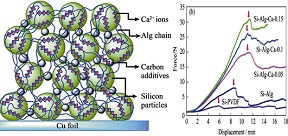
|
|
|
Evaluation of Low Density and Highly Thermal Conductive Carbon Bonded Carbon Fiber Network with Mesophase Pitch as Binder
OUYANG Ting, CHEN Yun-Bo, JIANG Zhao, FEI You-Qing
2019 Vol. 34 (10): 1030–1034
 Abstract
Abstract(
692 )
 HTML
HTML(
12)
 PDF
PDF(1003KB)(
811
)
The carbon bonded carbon fiber network was prepared by using carbon fibers carbonized at 500 ℃ with mesophase pitch as binder. The sample was compared with the one prepared by using carbon fibers carbonized at 1300 ℃and the one prepared by using phenolic resin as the binder. The carbon yields of binders, microstructure, graphitization degree and crystallite size of samples were characterized and thermal conductivity was obtained for the samples soaked into phase change materials (PCM) to form PCM composites. Results showed that a good “in-plane” bonding effect was formed between the highly aligned graphene layers of binders and graphite fibers. The density of the carbon fiber network after graphitization is 0.317 g?cm -3, and the in-plane thermal conductivity of its PCM composite is 19.30 W?m -1?K -1, increased by 80-folds as hhat of pure PCMs.
|
|
|
Stoichiometric Ratio on Phase Transformation in Reaction Sintering of BiFeO3 Ceramics Study: a High Temperature X-ray Diffraction Study
CHENG Guo-Feng, RUAN Yin-Jie, SUN Yue, YIN Han-Di, XIE Qi-Yun
2019 Vol. 34 (10): 1035–1040
 Abstract
Abstract(
503 )
 HTML
HTML(
7)
 PDF
PDF(976KB)(
772
)
The existence of impuritiy phases such as Bi25FeO39 and Bi2Fe4O9 has led to high leakage current in BiFeO3 multiferric materials, which consequently restricts further understanding of its coupling between magnetic and polarization orders. Prior to the attempts to synthesize pure-phase BiFeO3 ceramics, the phase transition involved in the reaction sintering should be clarified. In the present, the phase transformations during the reaction sintering process of BiFeO3 ceramics with different molar ratio of Bi2O3/Fe2O3 in air were studied via High Temperature X-ray Diffraction technique (HT-XRD), Rietveld refinement quantification, and High Temperature Raman Spectroscopy (HT-Raman). The thermal stabilities of BiFeO3, Bi25FeO39 and Bi2Fe4O9 ceramics were also studied by such methods. The qualitative phase distributions after heating were analyzed by Electron Backscattered Diffraction (EBSD). Results show that the phase transition from monoclinic to cubic for Bi2O3 was well done, which usually taken place at 700 ℃. The Fe2O3 did not react with Bi2O3 to form BiFeO3 until that transition finished. In addition, BiFeO3, Bi25FeO39 and Bi2Fe4O9 phases are not in thermodynamic stable state during the cooling process for Bi excess samples. Bi2O3 excess can effectively inhibit the formation of impurities and promote the sintering of BiFeO3 phase. The phase content of BiFeO3 mainly depends on the molar ratio of Bi2O3/Fe2O3, and 1.03 : 1 is optimum. Combining with our previous research results, it is found that the effective parameters for the synthesis of BiFeO3 strongly depend on the excessive Bi and rapid heating and cooling rate. This work may provide useful experimental guidance for the preparation of pure-phase BiFeO3 ceramics.
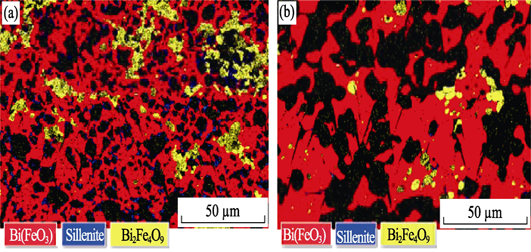
|
|
|
Measurement and Analysis of Cu2S Thermal Diffusivity during Phase Transition
CHEN Hong-Yi, SHI Xun, CHEN Li-Dong, QIU Peng-Fei
2019 Vol. 34 (10): 1041–1046
 Abstract
Abstract(
913 )
 HTML
HTML(
18)
 PDF
PDF(1067KB)(
911
)
Thermal diffusivity can be measured by the laser flash method. Previous study showed that Cu2S has extremely low thermal diffusivity during the first-order phase transition. However, when laser is applied on the measured sample, both the absorption/emission of light and the increase of temperature on the measured sample will occur. Their effects on the measurement accuracy of the thermal diffusivity during the phase transition have not been investigated yet. In this study, it is found that the absorption/emission of light has neglectable influence on the thermal diffusivity measurement of Cu2S. However, the increase of temperature can significantly influence the measurement results and shift the temperature when the thermal diffusivity of Cu2S starts to decrease below the starting temperature of the phase transition determined by DSC. This can be solved by building a Cu2S/graphite double-layer structure via using the graphite to absorb part of the laser’s energy. Furthermore, a thermal transport model is developed to extract the real thermal diffusivity from the measured thermal diffusivity of the Cu2S/graphite double-layer structure. This work is meaningful for accurate characterization and understanding of the thermal diffusivity of phase transition materials, photosensitive materials, and heat sensitive materials.
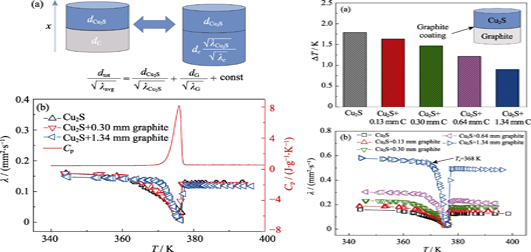
|
|
|
First-principles Study on Electronic and Magnetic Properties of Mn-doped Strontium Ferrite SrFe12O19
WANG Zhong, ZHA Xian-Hu, WU Ze, HUANG Qing, DU Shi-Yu
2019 Vol. 34 (10): 1047–1054
 Abstract
Abstract(
981 )
 HTML
HTML(
22)
 PDF
PDF(9191KB)(
831
)
To reveal influence of doping ions on the magnetic properties of strontium ferrite materials with magnetoplumbite configurations, we studied the stable configurations and magnetic structures of strontium ferrite with and without manganese doping. The results show that the strontium ferrite is ferrimagnetic, which is consistent with the previous reports. Comparing the GGA and GGA+U approaches, the U value exhibits a significant impact on the electronic structures and atomic magnetic moments. When 3.7 eV is adopted for U value, the system changed from a metal to a semiconductor with a spin up band gap of 1.71 eV. The total magnetic moment of the pure strontium ferrite is 40 μB. For the SrFe12-xMnxO19 system, the site preference of Mn substituting Fe is investigated with x=0.5 and x=1.0. When x = 0.5, the single doping Mn atom preferentially occupies the Fe (12k) site. For x=1.0, the two Mn atoms preferentially occupy the Fe (12k) and Fe (2a) sites, respectively. Doping Mn has little impact on the lattice structure of strontium ferrite, but have a significant effect on the total magnetic moments and electronic structures. When x=0.5 and x=1.0, the band gap values for spin up electrons reduced to 0.85 and 0.49 eV, and the total magnetic moments reduced to 39 and 38 μB, respectively. This study may provide a theoretical foundation for future experimental studies.
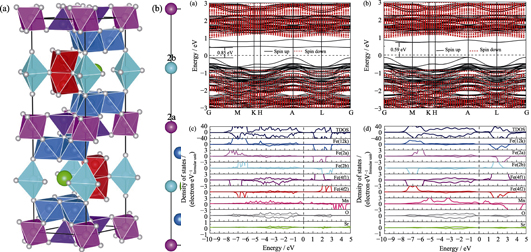
|
|
|
Flux Pinning Mechanism of Nb-doped YBCO Film
WANG Ya, SUO Hong-Li, MAO Lei, LIU Min, MA Lin, WANG Yi, KAUSAR Shaheen, ZHOU Yu-Qi
2019 Vol. 34 (10): 1055–1059
 Abstract
Abstract(
465 )
 HTML
HTML(
10)
 PDF
PDF(2004KB)(
666
)
Nb doped YBa2Cu3O7-x(YBCO) film was fabricated by metal organic deposition (MOD) method. BYNO thin film composed of Nb element was obtained with the size ranged from 20-30 nm. It is indicated that the epitaxial and random oriented BYNO nanoparticles were coexisted in YBCO film and mainly shows random orientation. Strengthening of nanostrains can be attributed towards the stacking fault parallel to the film and the lattice distortion around the BYNO nanoparticles inside the thin film. As the random fraction of BYNO increasing, the nanostrain within nanocomposites was strengthened. The nanostrain increases the magnetic flux pinning ability of the film, thereby improving the superconducting properties of the film under high magnetic field.
|
|
|
SiO2 Soot Body at Vacuum Sintering Process: Densification and Transparency Mechanism
NIE Lan-Jian, GU Zhen-An, WANG Yu-Fen, XIANG Zai-Kui, ZHANG Chen-Yang, RAO Chuan-Dong
2019 Vol. 34 (10): 1060–1066
 Abstract
Abstract(
853 )
 HTML
HTML(
7)
 PDF
PDF(4100KB)(
664
)
Low density and amorphous SiO2 soot body was prepared by chemical vapor deposition. Its macro deformation and micro-structure evolution rule in the sintering process were characterized by TG-DSC, SEM, TEM, XRD, mercury intrusion method, nitrogen adsorption method, and high temperature melting observation system, etc. The results indicated that SiO2 soot body began to shrink at the sintering temperature of 1000 ℃. The macro scale soot body stopped shrinking when the sintering temperature rose to 1200 ℃, with 30% ratios shrinkage. When the sintering temperature was higher than 1200 ℃, the small particles of SiO2 started to melt. There is a clear transition boundary between solid-phase soot body and liquid-phase glass body when the sintering temperature is higher than 1250 ℃. Meanwhile, it is interesting that the pores shape of soot body evolved gradually from connective to isolated, spherical and hole-closed. When the sintering temperature reached 1500 ℃, but the transparent silica glass is obtained without pores. More importantly, the state of SiO2 soot body remains amorphous throughout the sintering process.
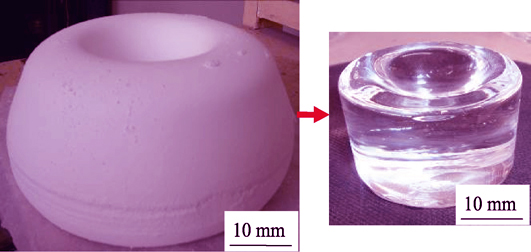
|
|
|
Fabrication and Property of Fine-grained MgO·1.44Al2O3 Spinel Transparent Ceramic
GUO Sheng-Qiang, WANG Hao, TU Bing-Tian, WANG Bin, XU Peng-Yu, WANG Wei-Min, FU Zheng-Yi
2019 Vol. 34 (10): 1067–1071
 Abstract
Abstract(
562 )
 HTML
HTML(
5)
 PDF
PDF(9787KB)(
721
)
Grain refinement is an effective way to enhance mechanical property of MgO·nAl2O3 spinel transparent ceramics. In this study, the porous body was firstly compacted and pre-densified by spark plasma sintering using pure phase MgO·1.44Al2O3 ceramic powder as raw material. Then, further densification at final stage has been achieved through pressureless sintering. Finally, a fine-grained MgO·1.44Al2O3 spinel transparent ceramic was fabricated by hot isostatic pressing at 1500 ℃ for 5 h under 180 MPa of argon. Pressureless sintering results show that narrowing the pore size distribution and reducing the average pore size can promote the densification process dramatically. And the pore-closed ceramic with average grain size of 1.4 μm and relative density of 96.7% was obtained. The transparent ceramic shows average grain size of 1.9 μm, Vickers hardness of (13.94±0.20) GPa and Young's modulus of 289 GPa. In addition, the 2-mm-thick product also displayed excellent optical transparency with the maximum transmittance 70% in visible region and 80% in infrared region, respectively.
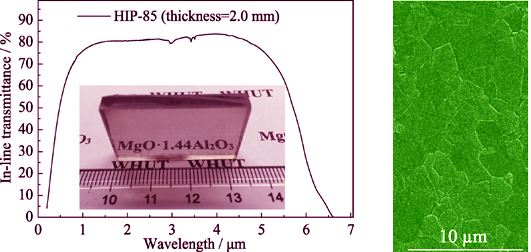
|
|
|
Preparation of ZnO·2.56Al2O3 Transparent Ceramics by Aqueous Gelcasting and Hot Isostatic Pressing
ZHANG Jin-Cheng, WANG Hao, XU Peng-Yu, TU Bing-Tian, WANG Wei-Min, FU Zheng-Yi
2019 Vol. 34 (10): 1072–1076
 Abstract
Abstract(
563 )
 HTML
HTML(
10)
 PDF
PDF(1879KB)(
816
)
Zinc-aluminum spinel transparent ceramics are typical multi-functional materials with excellent optical, thermal and dielectric properties. ZnAl2O4-Al2O3 ceramics green body were fabricated through aqueous gelcasting forming technique starting from the raw materials of ZnAl2O4 and Al2O3. The stable slurries of ZnAl2O4-Al2O3 with 50vol% solids loading were prepared. Furthermore, the effects of the dispersant, pH value and solid loading on the rheological properties were systematically investigated. Then, gel-casted green compacts were pressureless sintered and hot isostatic pressed to obtain transparent ceramics. Finally, transparent ZnO·2.56Al2O3 ceramics (1.8 mm in thickness) with in-line transmittance value of 70% in visible region and higher than 80% in infrared region were obtained. The samples exhibited Vickers hardness of (11.34±0.17) GPa, Young's modulus of 285 GPa.
|
|
|
Preparation of Zinc Oxide Mesocrystal Filler and Its Properties as Dental Composite Resin
LIU Yu-Ling, WANG Rui-Li, LI Nan, LIU Mei, ZHANG Qing-Hong
2019 Vol. 34 (10): 1077–1084
 Abstract
Abstract(
871 )
 HTML
HTML(
22)
 PDF
PDF(19321KB)(
992
)
The inorganic filler is the main component of the dental restoration composite resin, which is very important for the properties and functions of composite resin. In this paper, zinc oxide (ZnO) mesocrystal microspheres were prepared from Zn(NO3)?6H2O solution in presence of triethanolamine as the soft template by hydrothermal method, these microspheres were self-assembled by 37.5 nm ZnO crystallite and with good order. ZnO mesocrystal microspheres were modified with γ-methacryloxypropyl trimethoxysilane (γ-MPS) and subsequently mixed with modified SiO2 microspheres as fillers, and then added to the Bis-GMA/TEGDMA system to prepare the composite resin. Through morphology observation and performance test, it is found the filler is uniformly dispersed in composite resin. The one filled with 20wt% ZnO mesocrystals has excellent mechanical properties and wear resistance, among which the flexural strength and modulus reach 133 MPa and 9.8 GPa, respectively with the volume loss at 1.02 mm 3 after 3000 times of wearing, which was 88.7% and 90.8% lower than that of the composite resin filled with commercial ZnO microspheres and bare SiO2, respectively. Moreover, the antibacterial rate of zinc oxide composite resin against streptococcus mutans in the oral cavity reached 99.9%.
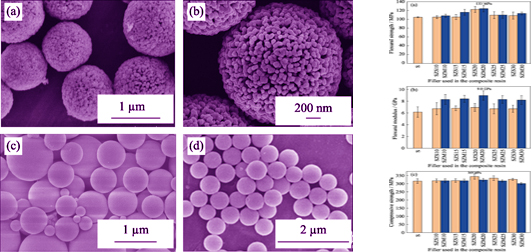
|
|
|
Structural and Depolarization Temperature of 0.94Na1/2Bi1/2TiO3-0.06BaTiO3:TiO2 Lead Free Composite Ceramics
SU Chun-Yang, JIANG Xiang-Ping, Chen Chao, Hu Hao, Liu fang, ZHENG Lai-Qi
2019 Vol. 34 (10): 1085–1090
 Abstract
Abstract(
574 )
 HTML
HTML(
7)
 PDF
PDF(4207KB)(
835
)
0.94Na1/2Bi1/2TiO3-0.06BaTiO3 (NBT-6BT) perovskite structure ceramics doped by nano-sized TiO2, which stayed in the grain boundaries of NBT-6BT grains, were prepared by the solid-state method. NBT-6BT: xTiO2 (x=0, 0.05, 0.1, 0.2, 0.3) 0-3 type composite structure ceramics were fabricated successfully and the effects of doped TiO2 on structure and piezoelectric properties were investigated in detail. The results show that some TiO2 enter into the lattice of NBT-6BT matrix, which result in a decrease of Cc phase content and an enhancement of crystal symmetry. The increasing amounts of TiO2 significantly improve the depolarization temperature of NBT-6BT ceramics. After doping 0.1 mol of TiO2, the depolarization temperature improves by 88%. The dielectric loss tanδ and piezoelectric coefficient d33 are 0.044 and 99 pC/N, respectively, which indicates that this kind of ceramic is a new type of lead-free piezoelectric materials suitable for higher temperature range.
|
|
|
Structure and Microwave Dielectric Property of BaAl2Si2O8 with Li2O-B2O3-SiO2 Glass Addition
HUANG Long, DING Shi-Hua, ZHANG Xiao-Yun, YAN Xin-Kan, LI Chao, ZHU Hui
2019 Vol. 34 (10): 1091–1096
 Abstract
Abstract(
533 )
 HTML
HTML(
8)
 PDF
PDF(2683KB)(
650
)
The BaAl2Si2O8-xwt%Li2O-B2O3-SiO2 (x=0, 0.1, 0.3, 0.5, 1.0, 2.0) ceramics with small amount of Li2O-B2O3-SiO2 (LBS) glass addition were prepared by solid state sintering. The sintering temperature, structure and microwave dielectric properties of BaAl2Si2O8 (BAS) ceramics with xwt%LBS glass addition were investigated. The results show that the LBS glass can greatly reduce the sintering temperature, promote the growth of grain and the transformation of hexacelsian-to-celsian of BAS ceramics. As x=0.1, all the hexacelsian were transformed into celsian, and the second phase was not observed as x≤2.0. The 0.3wt%LBS glass can promote the density, dielectric constant and Q × f value increase, and the absolute value of τf decrease. Especially, the BAS ceramics with the 0.3wt%LBS glass addition sintered at 1275 ℃ shows a good Q × f of 34570 GHz, and the dielectric properties are εr = 6.74 and τf = -15.97 × 10 -6/℃.
|
|
|
Synthesis of Na3V2(PO4)2F3@V2O5-x as Cathode Material for Sodium-ion Battery
WANG Jia-Hu, WANG Wen-Xin, DU Peng, HU Fang-Dong, JIANG Xiao-Lei, YANG Jian
2019 Vol. 34 (10): 1097–1102
 Abstract
Abstract(
779 )
 HTML
HTML(
12)
 PDF
PDF(864KB)(
962
)
Low energy/power density and inferior cycling stability are bottlenecks to restrict the applications of sodium-ion batteries. Recently, coating the surface of cathode material by metal oxides containing oxygen vacancies, was regarded as an effective strategy to improve electrical conductivity and power/energy density. In this study, Na3V2(PO4)2F3@V2O5-x nanosheets were synthesized via hydrothermal strategy followed by heat treatment. X-ray diffraction, transmission electron microscopy, scanning electron microscopy, X-ray photoelectron spectroscopy, and thermogravimetric analysis were applied to investigate the structure of Na3V2(PO4)2F3@V2O5-x. As a cathode of sodium- ion batteries, Na3V2(PO4)2F3@V2O5-x delivers excellent cycling stability and rate capability. It exhibits an initial discharge capacity of 123 mAh?g -1 at 0.2C, and a discharge capacity of 109 mAh?g -1 after 140 cycles. At 1C, its initial reversible capacity is 72 mAh?g -1, which remains 84% after 500 cycles. The outstanding electrochemical property could be ascribed to its enhanced sodium-diffusion and improved electronic conductivity induced by disordered surface coating. Furthermore, it encourages more investigations into practical sodium-ion battery applications.
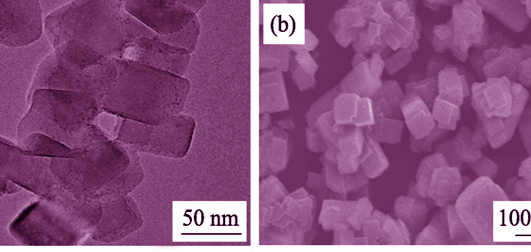
|
|
|
Fe2O3 on In-situ Synthesized SiCw/SiC Composite Ceramics for Solar Thermal Energy Storage
XU Xiao-Hong, TIAN Jiang-Zhou, WU Jian-Feng, ZHANG Qian-Kun, JIN Hao, DU Yi-Xin
2019 Vol. 34 (10): 1103–1108
 Abstract
Abstract(
481 )
 HTML
HTML(
2)
 PDF
PDF(1627KB)(
730
)
In order to improve solar thermal storage properties of the SiCw/SiC composite ceramics, in-situ growth and morphology of SiC whiskers (SiCw) were controlled by adding catalyst Fe2O3(0.5wt%-2.0wt%) on the basis of formula CF0 (SiC 69.21wt%, AlN 20.30wt%, Si 10.39wt%). Effect of Fe2O3 on morphology of SiCw as well as growth mechanism and properties of SiC composite ceramics were analyzed. Results indicated that SiCw growth mechanism changed from vapor-solid to vapor-liquid-solid after adding Fe2O3. The addition of Fe2O3 via adjusting solubility of C element into Fe-Si droplets, as well as firing temperature jointly controlled morphology of SiCw. The sample CF4 (Fe2O3 2.0wt%) fired at 1500 ℃ with whiskers diameter of 50-100 nm and 1-6 μm in length obtained optimal performance, the bulk density, bending strength, heat capacity and thermal conductivity were 2.19 g/cm 3, 45.08 MPa, 0.95 J/(g·K) (25 ℃), 18.15 W/(m·K) (25 ℃), respectively. The value of thermal conductivity increased by 169% compared to the sample without Fe2O3. The few defects and large-diameter of whisker grown by vapor-liquid-solid mechanism could improve thermal properties by reducing the matrix-whisker thermal barrier.
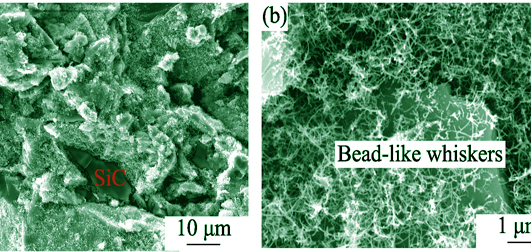
|
|
|
Synthesis and Evaluation of Ca-doped Sr2Fe1.5Mo0.5O6-δ as Symmetrical Electrodes for High Performance Solid Oxide Fuel Cells
XIA Tian, MENG Xie, LUO Ting, ZHAN Zhong-Liang
2019 Vol. 34 (10): 1109–1114
 Abstract
Abstract(
596 )
 HTML
HTML(
12)
 PDF
PDF(1893KB)(
988
)
A series of Ca-substituted Sr2Fe1.5Mo0.5O6-δ oxides, Sr2-xCaxFe1.5Mo0.5O6-δ (SCFMO, x=0, 0.2, 0.4 and 0.6), were synthesized and evaluated as potential electrodes for symmetrical solid oxide fuel cells. X-ray diffraction examination showed that all samples maintained cubic perovskite structure in both air and wet hydrogen atmospheres. Temperature programmed reduction measurements indicated that the Ca 2+ substitution promoted the catalytic activity of SCFMO toward oxygen evolution reactions. Symmetrical anode fuel cell measurements showed the lowest polarization resistance in humidified hydrogen emerged at x=0.6. Single cells-SC0.6FMO|La0.9Sr0.1Ga0.8Mg0.2O3(LSGM)|SC0.6FMO, fabricated via tape-casting and impregnation methods, produced peak power densities of 1.05 W·cm -2 at 800 ℃ and 0.41 W·cm -2 at 650 ℃ when operating on hydrogen fuels and air oxidants. These results demonstrate SC0.6FMO is a potential electrode material for symmetrical solid oxide fuel cells.
|
|
|
Renewable Porous Carbons Prepared by KOH Activation as Oxygen Reduction Electrocatalysts
HE Wang-Tao, MA Ru-Guang, ZHU Yu-Fang, YANG Ming-Jie, WANG Jia-Cheng
2019 Vol. 34 (10): 1115–1122
 Abstract
Abstract(
1016 )
 HTML
HTML(
25)
 PDF
PDF(1685KB)(
1097
)
The nitrogen-doped porous carbon applied for oxygen reduction reaction (ORR) has aroused extensive interests due to its unique physical and chemical properties. However, the complicated nitrogen-doping strategy and high cost limit its extensive application. In this work, a series of nitrogen-doped porous carbons were prepared by a facile pyrolysis process coupling with subsequent KOH activation using renewable N-enriched biomass potato as carbon source. Effects of activation temperature and KOH amounts on the textural properties and electrocatalytic ORR activities of the final samples were investigated in detail. The KOH activation treatment results in a high specific surface area (SSA) and hierarchical porous structure, which is beneficial for improved ORR performance. The optimized NPC-750 possesses a high SSA of 1134.2 m 2?g -1, developed hierarchical pores as well as moderate nitrogen content (1.57at%). It also exhibits a positive onset potential of 0.89 V (vs. RHE) and half-wave potential of 0.79 V (vs. RHE). Simultaneously, the advanced long-time stability and methanol-tolerance capacity were also obtained, implying that these biomass-derived porous carbons are potential low-cost ORR electrocatalysts. Moreover, these porous carbons show great potential in various fields including supercapacitors, adsorption/separation, catalysis and batteries as well.
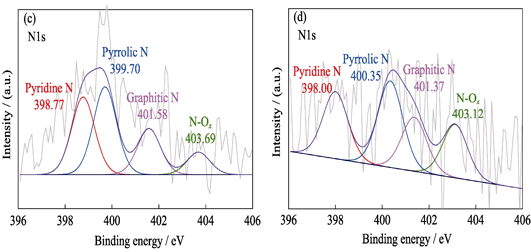
|
|
|
Synthesis of Fine AlN Powders by Foamed Precursor-assisted Carbothermal Reduction-nitridation Method
MAO Xi-Xi, XU Yong-Gang, MAO Xiao-Jian, ZHANG Hai-Long, LI Jun, WANG Shi-Wei
2019 Vol. 34 (10): 1123–1127
 Abstract
Abstract(
742 )
 HTML
HTML(
10)
 PDF
PDF(2314KB)(
793
)
A modified carbothermal reduction-nitridation (CRN) method was proposed to synthesize fine AlN particles using γ-Al2O3 and sucrose as raw materials which were pre-treated as cellular foams. The reaction procedure and the produced AlN were investigated by XRD, SEM and TEM. XRD result suggests that γ-Al2O3 transferred into AlN without transformation into α-Al2O3. HRTEM shows that γ-Al2O3 particles are covered by amorphous carbon from sucrose inhibiting the transformation of α-Al2O3 from γ-Al2O3 in the synthesis procedure. The foamed structure is of benefit to the diffusion of N2 and the produced CO. The minimum reaction temperature is 1450 ℃ for full conversion of Al2O3 to AlN. SEM photographs show the particle size of synthesized AlN is 50 nm. This study demonstrated an efficient way to synthesize fine AlN powders which are urgently required for the manufacture of advanced AlN ceramics.
|
|
|
Thermodynamic Stability and Thermal Expansion of Pure-phase BiFeO3
CHENG Guo-Feng, RUAN Yin-Jie, SUN Yue, YIN Han-Di
2019 Vol. 34 (10): 1128–1133
 Abstract
Abstract(
620 )
 HTML
HTML(
8)
 PDF
PDF(3404KB)(
767
)
The thermodynamic stability and thermal expansion of pure-phase BiFeO3 multiferroic are studied using in-situ high temperature X-ray diffraction (HT-XRD), and high temperature Raman spectroscopy (HT-Raman). BiFeO3 keeps its rhombohedral structure with space group of R3c in heating process. However, minor BiFeO3 could decompose to Bi2Fe4O9 and Bi25FeO39 in cooling process, which may be induced by its oxygen octahedron tilt distortion. In addition, the thermal expansion coefficients of BiFeO3 are also investigated, showing an isotropic and positive behavior. These results are further confirmed by Raman spectrum analysis. This work may benefit for the preparation of pure-phase BiFeO3.
|
|